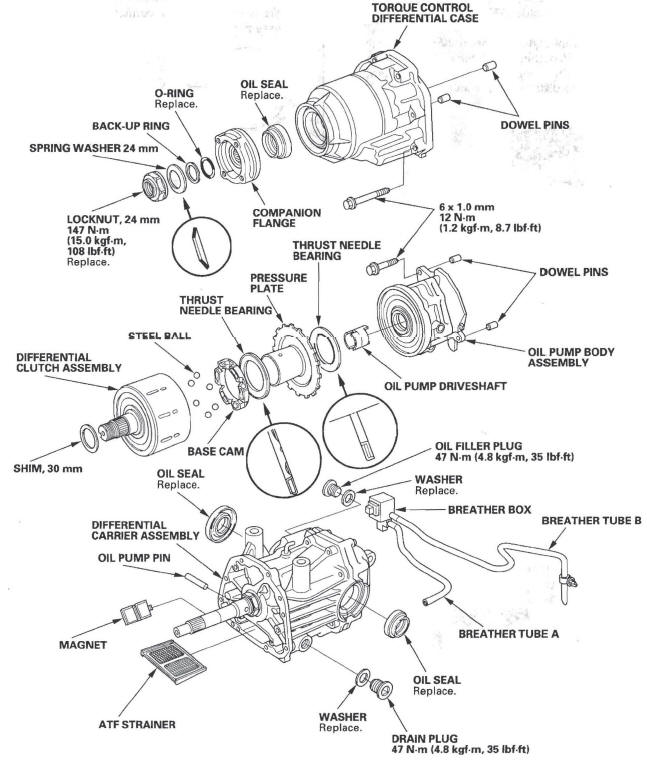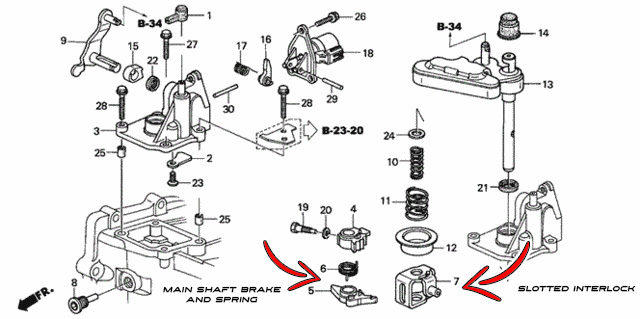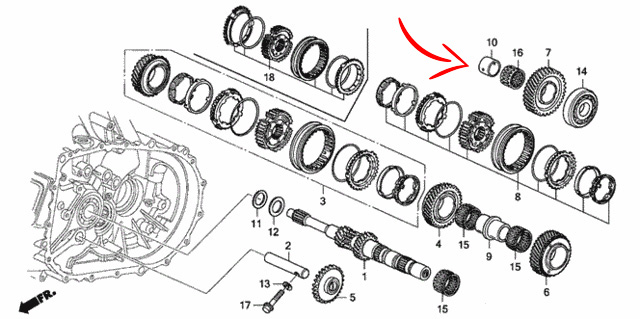Welcome to the Famspec Honda AWD Reference page. On this page we will cover just about everything mechanical related to B and K series AWD Transmissions, differentials, systems and everything in between. When completed this should be about the most complete guide and reference on the internet about this subject. Be patient it's ALOT to put into readable form with proper information and reference materials.
This section covers Honda Rear Differentials from 1997-2011 For Honda CR-V rear diff, Honda Element rear diff, and Honda Accord Crosstour differential.
For reference sake and because the question will come up: The Pilot, RDX, MDX, Ridgeline, have completely different carriers/assemblies CRV After 2011 have an electrically controlled rear diff.
1997 to 2011 Honda CR-V and Honda Element Rear differential differences:
97-01 CR-V rear diffs are probably the least desirable of the bunch. A first attempt by Honda and they improved the design for the 02-04 CRV and 03+ Honda Element. The clutches have the least amount of material on them on-top of the fact the earlier ones have an occasional manufacturing defect in the clutch basket itself that can cause failures. You also have to consider the fact that there are very few RD1 CRV's that have less than 150K miles on them and unless they were driven in an area where there is no snow or dirt and the clutches did not see regular action they are probably well worn.
02-04 CRV rear differentials benefit from an updated design and better clutches just like the Honda Element. There is some misinformation on other sites about this because the guy has NO idea what he is talking about because he loves theoretical engineering. I have personally pulled apart about 18 different differentials and have YET to find an 02-04 diff that did not have the same clutches as the Honda Element.
05.5+ Honda CRV/Crosstour rear differentials are a further improved design by Honda on the Dual Pump system. These feature an additional Ramp-up assembly that helps to deliver some rear grip instantly until the pump assembly takes over. This is a superior rear differential in factory form.
03+ Honda Element rear differentials are all the same as the 02-04 CRV. For some reason Honda did not switch over to the Ramp-Up style diff on these after 2005.
Upgrading your differential:
The first thing you need to decide is what is it you really want? Are you just wanting more grip for the occasional ski trip? Are you in severe weather often enough that you want some serious grip? Are you going performance or using a CRV diff for drag racing? Because there are vastly different ways to approach these scenarios and one solution does not fit all. Lets break this up into performance levels 1-4
Level 1 Upgrades (street use with occasional extra use)
Any differential will benefit from a Fastrac upgrade kit. BUT the best setup is the Ramp-Up style diff with the Fastrac kit. Again, the 97-01 differentials do not have great clutches and are probably worn out. You also have to consider the fact that non OE fluid might have been run in the rear differential and that can lead to damage so the newer the diff the better chance you have that it is in tip top shape. Tip: if you are going to buy a diff try to get one from a state that does not see a lot of extreme weather for least wear on clutch packs.
Level 2 Upgrades (Overlanding or extreme weather areas)
Again, same as level 1 you probably want to just swap over to an 05+ Ramp Up style rear diff with a Fastrac kit. BUT, you also really are going to want to consider installing a Gear X rear LSD. I DO NOT SUGGEST processive style rear LSDs. after testing a no name and a brand name one they BOTH contaminated the oil in the rear diff with metal shavings and have an unpredictable nature about them on top of the potential to break the differential completely.
Level 3 and 4 Upgrades (Performance)
This is where it gets tricky. The problem is the dual pump system is not capable of holding extreme power and there is much controversy surrounding this. Some people lock the clutch plates and ad another VC (viscous coupler) from a Range Rover Freelander into the joint in the driveshaft. The VC is capable of splitting the power evenly and holding up to abuse. Others try to use the Racing Diffs clutch pack upgrades and there is problem with those. The problem is they work... but they also not work correctly. They are TOO rough and can overheat easily and disintegrate plus you have to run a different fluid for them to work that affects how the Dual pump assembly actually works. So what is the solution? You can bolt in a wagovan diff with an LSD and run a VC but they are overpriced and hard to find. You can buy some AKD CAST BILLET (yes. its cast aluminum machined to look like billet) VC trash and have it fail on you because nothing he makes actually works in the long run and there is a deep online history on multiple vehicle platforms about this topic This one is fun to watch
The real answer is to build both your transmission and ad an LSD, plus build your rear diff with an LSD and a GearX viscous coupler when they come back out again. No matter what you do something in the diff with fail if you try and use the clutch basket in any way including pinning or locking the clutch plates. The diff is actually engineered to fail the main shaft has a break area on it just to make sure the rear end does not lock up in any way if the dual pump assembly fails. So if you push it too far that shaft will break and you need to replace that as well.
My badass diff upgrades consists of Gear X ring gear and shaft, LSD, and Gear X Viscous Coupler for the CRV rear diff and a custom driveshaft from the the driveshaft shop.
Controversy and opinions about Fastrac kits.
The Fastrac Kit AKA crv quick spool or DPQS or whatever someone calls it. There are 3 main people who have made this over the years and one of them likes to talk.... ALOT. This guy who I am not going to name because he doesn't deserve to be named is absolutely notorious for ripping people off and selling bunk parts because he has NO way of testing things other then sending them out into the world and risking other peoples lives. He also claims to be a legitimate business person but waits 2.5 years or more to supposedly ship multi thousand dollar AWD kits to people who do not want them and have been asking for their money back for years at this point. Again, kits with ZERO testing in house. Check out the performance AWD Honda group on Facebook and give him a search and see the horror of doing business with that ma.... guy was going to say man but that's a stretch.
He talks about drilling out the oil hole in the pump assembly that it will ruin it and it will not build pressure. That's nice, has he ever tested it? tried it? Nope how can he when he doesn't have any way to test it because he does not own, race, or build any vehicle that uses these differentials. We here have CRV's Elements and an AWD RSX in house that we HAVE actually tested things on. Guess what? My diff still works and also engages faster and provides me with more traction and I drive one of my vehicles at least every day. What can he say other than opinion.. just shut up and focus on running an honest business there pumpkin..

Upgrading K series 5 speed AWD transmissions:
There are so many ways to do this it blows the mind. The AWD K series transmission uses the same gears as the FWD K series transmissions so strength is not an issue. Its also very simple to add a 6th gear just like the TSX, RSX and Civic SI transmissions. the 6 speed parts literally just bolt in and you can modify the existing shift fork easily to work. I will post step by step instructions to go with the 6 speed kits we will be offering soon.
The plain and simple fact is the best upgrade you can do to ANY Honda Transmission is simply an LSD. You can get AWD specific aftermarket LSD's or find a factory 06-11 Civic SI LSD and modify it to fit. My supercharged Element has a factory LSD that was machined to accept the AWD ring gears and clear the bolt heads from the case. There are a few ways to fuck this pig. One of the most popular upgrades for Honda Element AWD manual transmissions and CRV is to do a 6 speed conversion that bolts right into the Honda Element Transmission and the CRV Manual transmission.
Honda Element Six Speed Conversion and CRV 6 speed conversion Parts with factory Part numbers.
This is the stuff you MUST have or change to convert your AWD 5 Speed Honda Element or CRV transmission to 6 speed. Some things maybe shortcut or bypassed but the right way to do it is to buy all the parts new below. To add 6th gear to your Honda AWD transmission you need 6th gear parts from an RSX Type S six speed transmission. You can also use gears from an 06-11 Honda Civic SI or a 6 Speed Acura TSX transmission if you want a bit more top end. The RSX main shaft gear is NO LONGER available new from dealerships so used or aftermarket is your only choice. If you are doing this into an Element or CRV I recommend the TSX six gear set JUST for the main and countershaft gears.
Remember.. if you have the transmission apart, just do yourself a favor and replace the axle seals while it is out, and if you can swing it just replace the input shaft bearing and seal because you SHOULD. ALWAYS USE HONDABOND HT. that black shit or the red stuff is always a warning sign to me that the transmission was apart and probably half assed together.
One more note... if you are going to paint it.. make sure you use CAST aluminum engine paint and not that shiny shit. and Please do it while its apart do not paint over the bolts, and seals, and plugs its just trashy looking and if you are doing it, just do it right, have some pride.
(These are Acura PN's not Honda they do not interchange at dealerships)
24201-PNS-010 6th gear fork - You do not have to buy this, you can remove the pin from the 5 speed fork and remove the 5 speed reverse fork slider and slip on the 6th speed one.
24240-PNS-000 Reverse shift fork slider - Required
24430-PNS-000 Slotted Interlock - You can modify the 5 speed one (more info below) (currently backordered with no date for availability as of 10/17/22)
24412-PNS-000 Main shaft brake - Nice to have but not required
24413-PNS-000 Spring for main shaft brake - Only buy if you change the main shaft brake.
23491-PNS-000 6th gear countershaft - Required BUT, you can do the 06+ Civic SI or the TSX gears
23590-PNS-000 Main gear (discontinued) - Get Used or get a 06 Civic SI or TSX gear set or go aftermarket.
Update: You also need 23626-PNS-305 You need the outer slider for the 5-6 hub and slider. You can use the 5 speed hub but you need the 5-6 slider ring.
91207-PP3-003 Dust seal - Because you should
6th gear synchro set. Now there are videos where you can just use the 5 speed one and technically it works BUT people have experienced failures and pop outs because there is nothing for the inner synchro race to sit against so you should just get the right parts.
I recommend: Synchrotech synchro 5-6 This is the Brass but you can also do carbon or just replace ALL of them and the bearings and that is what you SHOULD do but we all have budgets and if you are not going performance and your trans has no issues then no worries.



Other Upgrades to the Element and CR-V AWD K series transmission.
Again there are so many ways to do this and really it depends on your application so lets do a rundown of what you should do, and what you can do. We will not be talking about any Full on drag racing setups in this section.
- Limited Slip Differential (LSD) In my opinion and experience this is the #1 upgrade you should always do if you are doing anything to a transmission. The majority of Honda Transmissions are what is called an "Open Differential" meaning there is no locker in place of any kind (there are few different types) and only one wheel at a time is getting power at any time. So essentially your vehicle is one wheel drive. Wrap your mind around the fact if you have AWD drive and no LSD in the front or the rear that your 4wd vehicle is essentially 2wd at any time. When it comes to Limited slips in an AWD transmission you have a few options. You can use a FWD LSD if you have it machined. My Element has a factory LSD from an 06 Civic SI that was machined so it would fit the AWD ring gears. On FWD setups the gear bolts to the diff and the diff has the threaded holes for the bolts. But on the AWD K series the bolts go though the diff and the main gear and the treads are the transfer case gear. So you have to have the diff holes opened up and you have to machine material off the top so that once bolted in the bolt heads are recessed lower so they do not hit the case. Most machine shops can do this process (see pic). Now if you want something a little more sporty than a factory LSD there are a few options such as Wavetrac, GearX, and MFactory. DO NOT, FOR ANY REASON, USE A PHANTOM GRIP STYLE LSD OR WELD YOUR FRONT DIFF. If that shit actually worked good everyone would do it.
- Upgraded Synchro's If your transmission has some miles on it, some abuse and you want to make sure its absolutely reliable and butter smooth you want to replace/upgrade your synchro's.
- Detent Springs This is what I would call a positive and negative upgrade for reasons you may not expect. Detent springs are small springs that are part of an assembly that works with the shift forks. The forks at the top have little notches in them representing different positions. Inside these slots are small steel balls that are being pushed into these slots with the detent springs. When you shift you not only hear the collar move and bind the gear to the shaft but you also head a distinctive click. That click is not in the shifter itself it is the balls on the detent being pushed into place. Stiffer detent springs dramatically improve shift feel but also dramatically increase the sound of the click. This is great if you have a race car or want that race car feel. But, in my CRV with stock exhaust shifting the noise gets a little annoying and I have tried all the major brands and its basically the same spring over and over with different coatings. They all work great but, if you want something that gives you more than stock and not quite race car feel we developed what we call "street car" Detent springs that are not quite as aggressive. If you want the best you can get, I would suggest Speedfactory or K-Motor.
5 Speed AWD/FWD RSX, Element, CRV, and Accord K Series Shift Selectors VS 6 Speed K Series Shift Selectors:
This is a subject with a lot of partial and false information available out there on the net. The thought of just putting 6th into a 5 speed AWD transmission and modifying the forks but NOT modifying the shifter is just silly. When you ad 6th gear you are adding a whole other bracket for the reverse gear as it is even further over and down. As show in the diagrams above you can see the parts you need or have to modify but there is also another issue you cannot see.
Six speed vehicles have a reverse lockout solenoid ON the selector itself that does exactly what it is called. Locks you out from being able to miss shift into reverse instead of 6th. Now right now I hear you, if this is an issue you are looking up you are probably thinking "I would never do such a rookie move" But its a thing for a reason because people make mistakes and you might not be the only person who drives your vehicle. You cannot ad this to a 5 speed shifter either, you can add the parts to make it shift correctly but you cannot ad the lockout without major work. So your option is to just USE a six speed shifter if you want the lockout.
If you have something like a base RSX or using a base RSX harness into any swap platform you can simply take the plug for the secondary runners off the intake manifold for the k20a3 and use it as your lockout plug with a simple re-pin. But, If you are trying to put a six speed conversion into something like a CRV, Element or Accord you will NOT have the ability to just re-pin because your ECU will not support it in the first place.
So basically if you want the lockout you are going to have to figure out how to disable the lockout when it is time to go into reverse. You cant use the clutch activation, or the reverse switch so what do you do? Let me know if you figure it out!
Transfer case:
The k series and the b series AWD transfercase both have their strengths and weaknesses.
The simple fact on both cases is the same: You either upgrade it all or you leave it stock and here is why.
The cases often fail because the housing cracks. But why does the housing crack? well it is cast aluminum and is distributing forces to the rear diff and was not made for 5000 RPM launches at 500HP. So the first answer is to upgrade the case with a fancy billet aluminum case made by multiple manufactures like Drag Cartel or Speedfactory. So now you have your upgraded case and your ready to give it hell.. Well now the internals are going to break and then damage your fancy billet case. So you can replace the part that failed and get a new case and then just break a different part and do it all again OR. You just upgrade it all at the same time and spend more time racing and less time fixing stupid shit and really that is all there is to it.
DRIVESHAFTS:
Manual Element: 78.25 inches (compressed)
Manual CR-V Driveshaft: 80.39 Inches (compressed)
Automatic CR-V Driveshaft: 79.53 Inches (compressed)
Sometimes on Honda CRV and Honda Element the driveshafts are actually broken at the slip joint. That's the joint in the middle that joins the two halves. Not the mount but its a Tripod style joint that has a boot and often tears and breaks. I could not figure out for the longest time why my rear diff on my element did not work while under power and discovered that the driveshaft was bad when you put any torque to it. I also found this on a customer's CRV who claimed my quick spool kit for his CRV diff did not work.
The simple fact is this, the driveshaft wears just like an axle does just not quite as fast. Check it to make sure you are getting the power to the rear. When it comes to HP limits, that joint is a weakness but also so are the ends and the flanges. Most people who put any real power down just shatter the old 200k driveshaft so consider upgrading this when you get the chance.
AXLES:
Odds are that the axles in your high mileage CRV or Honda Element have been replaced with aftermarket unit. The internet is FILLED with claims that only OEM ones work or you will have a wobble. This is true and it is false at the same time. You see, old worn in axles have very little resistance because the joints are worn. Brand new axles are stiff as hell so when you drive on them they are going to wobble the engine and trans.. Why? because your mounts are probably worn out and stiff joints are going to be able to flex those mounts and make the wobble very noticeable. Despite what many people on CRV and Element pages and groups say, the aftermarket axles are NOT poorly made and are "bent" its just that everything is worn out and, right out of the box they are extremely stiff. Replace your mounts, your worn out compliance bushings and put a few hundred miles on them and then see if they still wobble as bad. 20 year old vehicles have issues folks... when you throw in one new part it exploits all the other worn out parts around it.
CR-V Front Passenger Length: 24.3 Inches (compressed)
CR-V Front Drivers Length: 26.1 Inches (compressed)
CR-V Rear Axle Length: Passenger side 31.45 Inches (compressed)
CR-V Rear Axle Length: Driver side 29.2 Inches (compressed)
Element Rear Axle Length: Driver side 29.6 Inches (compressed)
Element Rear Axle Length: Passenger side 31.6 Inches (compressed)
Element Front Axle Length: Driver side 26.7 Inches (compressed)
Element Front Axle Length: Passenger side 24.8 Inches (compressed)
Are they all interchangeable? In the front yes, rear kinda? If you lift a CRV using Element axles in the rear gives you some extra length.
The axles are the same for both Automatic and Manual.
